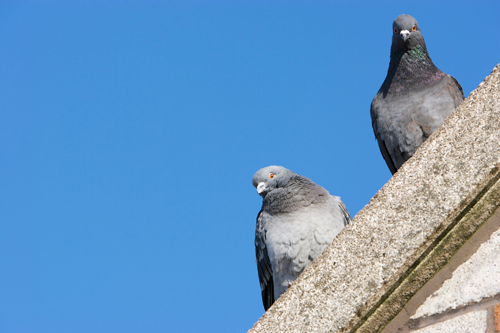 by Fran Prisco
by Fran PriscoPigeons can be found in just about every city and suburb in North America. They were first introduced to the United States as domesticated birds that soon escaped and formed wild pigeon populations. Ancestors of the Rock Dove, city pigeons like to roost and nest high atop buildings where there is safety from predators. They cause thousands of dollars every year to buildings and homes across the country. The droppings of pigeons are acidic and will accelerate the deterioration of building materials. Pigeon droppings also can carry any of 60 plus transmitted diseases. The best way to keep pest pigeons off of buildings is to install some sort of bird barrier .
Sanitation
It is important that all debris and droppings left behind by the pigeons is removed before installing any type of bird barrier . Inhaling the dust from pigeon droppings has been known to cause histoplasmosis, cryptococcus and psittaicosis. If you use some simple protective methods while cleaning up pigeon droppings, you can eliminate the danger of catching any of the above-mentioned diseases. Be sure to wear some sort of protective gear such as a facemask and rubber gloves. Wet pigeon droppings with water so that they do not emit any dry dust, use a scraper to scrape the wet droppings into a dustpan and dispose of them in trash bags.
Types of Bird Barriers
Electric Bird Barriers are electrified track that give pigeons a small “jolt” when they touch the track. They are easily installed on parapet walls, roof edges and peaks, ledges and even channel letters. Install the track with an outdoor adhesive and connect to a solar or direct charger. When the pigeons are “Zapped” by the electrical current running through the track, they will change their landing and roosting habits and find another more comfortable area. Electric bird repellents are low profile, usually no more than ¼” high, which does not take away from the buildings aesthetics. These bird control electric tracks are one of the most specified systems by architects, government offices and contractors.
Bird Netting is used on and in commercial buildings with severe bird problems. Bird net is an exclusionary bird deterrent; it excludes birds from areas that they are unwanted. Bird netting is ideal to use in large warehouses, airplane hangars, “Big Box” stores and food processing plants. It can also be used on building facades to protect signs, channel letters and architectural features. It is best to hire a professional to install bird netting , if not done properly, the netting may sag and allow birds to get underneath it.
Bird Spikes are an ideal way to keep larger birds such as pigeons and gulls from landing on commercial buildings. They are easily installed using adhesive, screws or tie downs. Use bird spikes to keep birds from landing on ledges, roof edges and peaks, parapet walls, windowsills and other flat surfaces. Be sure to cover the entire surface with bird spikes so the birds cannot land around them. Often times, if birds can land around the spikes, they will use them as a nesting area. Made from stainless steel or polycarbonate plastic, bird spikes are rugged and long lasting bird barriers . Once installed there is little maintenance; periodic cleaning of debris buildup from nearby trees or shrubs is all it takes.
 RSS Feed
RSS Feed